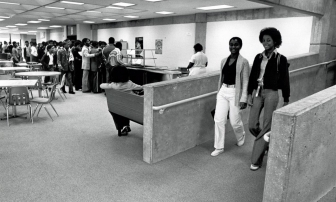Schools and Prisons: Further Reading
American Architectural Foundation, Report from the National Summit on School Design (Washington, DC: American Architectural Foundation, 2006).
American Federation of Teachers, Building Minds, Minding Buildings: Turning Crumbling Schools into Environments for Learning (Washington, DC: American Federation of Teachers, 2006).
Henry Barnard, School Architecture: Or, Contributions to the Improvements of School-houses in the United States (New York: A. S. Barnes & Co., 1854).
Jeremy Bentham, Panopticon; or, The inspection-house: containing the idea of a new principle of construction applicable to any sort of establishment, in which persons of any description are to be kept under inspection and in particular to penitentiary-houses, prisons … work-houses … and schools (London: Reprinted and sold by T. Payne, 1791).
Susan Black, “Achievement by Design,” American School Board Journal (October 2007): 39–41.
Iva E. Carruthers, “Centennials of Black Miseducation: A Study of White Educational Management,” Journal of Negro Education 46, no. 3 (Summer 1977): 291–304.
Carol Cash and Travis Twiford, “Improving Student Achievement and School Facilities in a Time of Limited Funding,” International Journal of Educational Leadership Preparation 4, no. 2 (April–June 2009).
Michael Clapper, “School Design, Site Selection, and the Political Geography of Race in Postwar Philadelphia,” Journal of Planning History 5, no. 3 (2006): 241–263.
David K. Cohen, “Education and Race,” History of Education Quarterly 9, no. 3 (Autumn 1969).
Larry Cuban, “The Open Classroom,” Education Next 4, no. 2 (2004), accessed January 24, 2009, http://educationnext.org/files/ednext20042_68.pdf.
John Dewey, Democracy and Education: An Introduction to the Philosophy of Education (New York: Macmillan, 1916).
John Dewey, Experience and Education (New York: Macmillan, 1938).
John Dewey, The School and Society (Chicago: University of Chicago Press, 1899).
Michel Foucault, Discipline and Punish: The Birth of the Prison (New York: Vintage Books, 1979).
Paulo Freire, The Pedagogy of the Oppressed (New York: Seabury Press, 1970).
Richard Hatch, “Planning for Change: Towards Neighborhood Design and Urban Politics in the Public Schools,” Perspecta 12 (1969).
bell hooks, Teaching to Transgress: Education as the Practice of Freedom (New York: Routledge, 1994).
Rebecca Klein, “Moving Student Photos Document School-To-Prison Pipeline,” Huffington Post, November 3, 2014, accessed by January 8, 2015, http://www.huffingtonpost./com/2014/11/03/critical-exposure-school-to-prison-pipeline_n_6094376.html.
Eric Margolis, “Looking at Discipline, Looking at Labour: Photographic Representations of Indian Boarding schools,” Visual Studies 19, no. 1 (2004): 72–96.
Horace Mann, Lectures on Education (Boston: W. B. Fowle and N. Capen, 1845).
L. E. Maxwell, “A Safe and Welcoming School: What Students, Teachers, and Parents Think,” Journal of Architectural and Planning Research 17, no. 4 (2000): 271–282.
Torin Monahan and Rodolfo Torres, eds., Schools Under Surveillance: Cultures of Control in Public Education (New Brunswick, NJ: Rutgers University Press, 2009).
Tuntufye S. Mwamwenda and Bernadette B. Mwamwenda, “School Facilities and Pupils’ Academic Achievement,” Comparative Education 23, no. 2 (1987): 225–235.
Oscar Newman, Defensible Space: Crime Prevention Through Urban Design (New York: Collier Books, 1973).
New York Civil Liberties Union, A, B, C, D, STPP: How School Discipline Feeds the School-to-Prison Pipeline (New York: NYCLU, 2013).
New York Civil Liberties Union and American Civil Liberties Union, Criminalizing the Classroom: The Over-Policing of New York City Schools (New York: NYCLU/ACLU, 2007).
Debra M. Pane and Tonette S. Rocco, eds., Transforming the School-to-Prison Pipeline: Lessons from the Classroom (Rotterdam: Sense Publishers, 2014).
Joseph M. Piro, “Foucault and the Architecture of Surveillance: Creating Regimes of Power in Schools, Shrines, and Society,” Educational Studies: A Journal of the American Educational Studies Association 44, no. 1 (2008): 30–46.
Richard Henry Pratt, Battlefield and Classroom: Four Decades with the American Indian, 1867–1904 (New Haven: Yale University Press, 1964).
John Raible and Jason G. Irizarry, “Redirecting the Teacher’s Gaze: Teacher Education, Youth Surveillance and the School-to-Prison Pipeline,” Teaching and Teacher Education 26 (2010): 1196–1203.
Frederick A. Rodgers, The Black High School and Its Community (Lexington, MA: Lexington Books, 1975).
Rajiv C. Shah and Jay P. Kesan, “How Architecture Regulates,” Journal of Architectural and Planning Research 24, no. 4 (2007): 350–359.
Shannon D. Snapp, Jennifer M. Hoenig, Amanda Fields, and Stephen T. Russell, “Messy, Butch, and Queer: LGBTQ Youth and the School-to-Prison Pipeline,” Journal of Adolescent Research 30, no. 1 (2015): 57–82.
Amy Sosnouski, “Visualizing Normality: Iconology and Symbolism in United States Schools” (PhD diss., University of Wisconsin-Madison, 2003).
Alison Stewart, First Class: The Legacy of Dunbar, America’s First Black Public High School (Chicago: Chicago Review Press, 2013).
C. Kenneth Tanner, “Effects of School Design on Student Outcomes,” Journal of Educational Administration 47, no. 3 (2009): 381–399.
Emmeline Taylor, Surveillance Schools: Security, Discipline and Control in Contemporary Education (London: Palgrave Pivot, 2013).
George E. Thomas, “From Our House to the ‘Big House’: Architectural Design as Visible Metaphor in the School Buildings of Philadelphia,” Journal of Planning History 5 no. 3 (August 2006).
Cynthia L. Uline and Megan Tschannen-Moran, “The Walls Speak: The Interplay of Quality Facilities, School Climate, and Student Achievement,” Journal of Educational Administration 46, no. 1 (2008): 55–73.
Cynthia L. Uline, Megan Tschannen-Moran, and Thomas DeVere Wolsey, “The Walls Still Speak: The Stories Occupants Tell,” Journal of Educational Administration 47, no. 3 (2009): 400–426.
“Urban Education: The New Challenge,” Educational Researcher 6, no. 9 (October 1977).
Donald Warren, “Original Intents: Public Schools as Civic Education,” Theory Into Practice 27 (1988): 243–249.
Louis N. Williams and Mohamed El-Khawas, “A Philosophy of Black Education,” Journal of Negro Education 47, no. 2 (Spring 1978).
Work Conference on Curriculum and Teaching in Depressed Urban Areas, Education in Depressed Areas (New York: Bureau of Publications, Teachers College, Columbia University, 1963).
✓ Not peer-reviewed
Amber Wiley, “Schools and Prisons: Further Reading,” Aggregate 3 (March 2015), https://doi.org/10.53965/ULRP4224.
